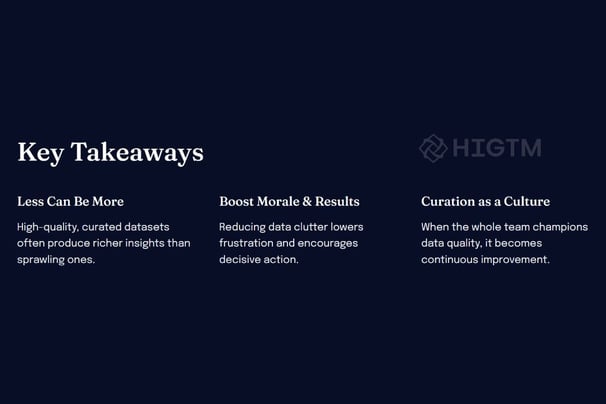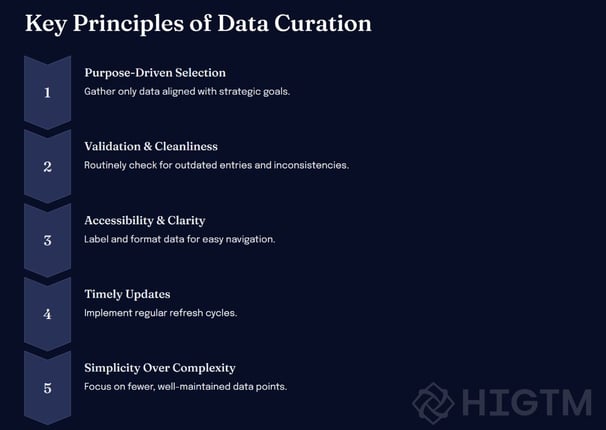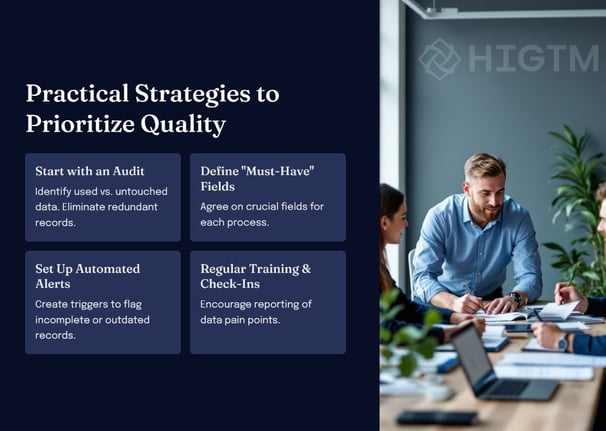20. Why Data Quality Beats Quantity: The Emotional and Strategic Power of Curation
Data pours in from every corner—social media interactions, website logs, customer feedback forms, production line sensors. Many organizations, especially small and medium-sized enterprises (SMEs), respond by hoarding as much data as possible, hoping that bigger equals better. But in reality, excessive, poorly curated data can drain team morale, inflate costs, and lead to weak decision-making. This in-depth exploration reveals why data quality trumps sheer volume, offering a roadmap to consistent, meaningful insights.
Q1: FOUNDATIONS OF AI IN SME MANAGEMENT - CHAPTER 1 (DAYS 1–31): CORE AI CONCEPTS & VALUE PROPOSITION
Gary Stoyanov PhD
1/20/20256 min read

1. The Growing Burden of Data Overload
1.1 The Paradox of Choice
More data theoretically means more insights. However, teams often face “analysis paralysis”—they see so many metrics, dashboards, and spreadsheets that deciding where to focus becomes a daily struggle. Instead of feeling empowered, employees can feel trapped in a fog of information.
1.2 Emotional Toll on Teams
Frustration: Imagine a sales manager combing through thousands of unverified leads, unsure which are valid.
Guilt: Data scientists can feel they’re failing when they can’t process every data stream.
Anxiety: Leaders hesitate to make decisions, worried they might be ignoring hidden information.
Such emotional strains have real consequences: decreased productivity, eroded trust in the data, and staff burnout.
1.3 Cost vs. Value
Maintaining vast data repositories—through cloud storage bills, analytics tool subscriptions, and IT overhead—quickly eats into budgets. If half those records are irrelevant, you’re essentially paying to keep a digital junk drawer. For SMEs with tighter finances, this can be particularly damaging.
2. Understanding Data Quality: What Truly Matters
2.1 Accuracy
Incorrect entries, duplicated records, or mislabeled attributes skew any analysis. Accuracy becomes the bedrock for any insight you draw—no matter how advanced your AI or business intelligence tools are.
2.2 Relevance
Collecting data on weather patterns might be fascinating, but if your business deals in software licensing with minimal correlation to weather, that data is clutter. Relevant data tightly aligns with your organization’s goals: Are you trying to understand customer churn? Optimize staffing hours? Expand into a new market?
2.3 Timeliness
Stale data can cause a sense of despair when teams notice they’re using last quarter’s sales metrics or months-old product feedback. Real-time or regularly updated data fosters confidence and encourages proactive decision-making.
2.4 Completeness
Partial records, such as customer files missing contact details or product entries lacking price info, lead to guesswork. Thorough data ensures no vital piece of the puzzle is overlooked.
2.4 Consistency
Ever encountered one system that codes a client as “Client 001” while another calls them “BlueLake Industries (001)”? Inconsistent naming or formatting can create chaos. Consistency allows for seamless merging, comparison, and analysis across departments.
3. The Emotional Payoff of Quality Data
3.1 Confidence and Speed
When a dataset is curated, employees know it’s trustworthy. They can move faster—whether that’s launching a new email campaign or deciding which product lines to expand. This confidence often translates into improved morale, since teams feel supported by reliable information rather than hampered by guesswork.
3.2 Reduced Workplace Tension
It’s demoralizing when the marketing department accuses finance of having “bad” numbers, or operations questions IT’s system logs. Curated data fosters harmony, creating a single source of truth that minimizes finger-pointing and blame.
3.3 Empowerment
Less extraneous noise means each piece of data has a purpose. Employees gain clarity on how their specific metrics drive overall company goals. This alignment elevates a sense of mission, making each person’s work feel more meaningful.
4. Key Principles of Data Curation
4.1 Purpose-Driven Collection
Before capturing any new data point, ask, “How will this be used?” If you can’t justify it from a strategic or operational perspective, spare yourself the clutter. By staying aligned with business objectives—like expanding a product line or improving customer service—your data remains relevant.
4.2 Streamlined Tools & Systems
Consolidate where possible. Using a single CRM for leads, a single ERP for inventory, or a unified cloud platform for analytics prevents fragmentation. Each additional system introduces fresh opportunities for mislabeling or duplication.
4.3 Clear Guidelines & Training
Teams need well-documented processes to keep data accurate. For instance, specifying how to label product categories or standardizing fields for a lead’s contact info can drastically cut back on confusion. Regular training sessions anchor these guidelines, making them second nature to staff.
4.4 Ongoing Maintenance & Audits
Curation isn’t a one-time event. Over months or years, data can drift out of relevance, new fields may be introduced without sufficient oversight, and external factors—like supplier changes—can affect records. Scheduling periodic audits ensures your data doesn’t revert to chaos.
5. Practical Strategies for SMEs
5.1 Conduct a Data Inventory
Take a day (or a week, depending on volume) to catalog all major data sources—spreadsheets, CRMs, marketing platforms, and more. Identify overlaps and note which data is seldom touched. This reveals immediate opportunities for consolidation or deletion.
5.2 Classify “Must-Haves” vs. “Nice-to-Haves”
Not every detail needs capturing. Perhaps you only need a customer’s name, email, and purchase history—no need for birthdates or employer info if it’s not relevant to your marketing strategy. Eliminating irrelevant fields significantly reduces clutter.
5.3 Regular Purging & Archiving
If data must be kept for legal or historical reasons, set up an archive system separate from everyday tools. Active systems then remain lean, while older records remain accessible if truly needed, preventing immediate confusion. revenue uplift from reduced miscommunication.
5.4 Shared Oversight
Appoint a cross-functional committee—representatives from marketing, IT, operations, and finance—to discuss data curation challenges. This ensures each department’s needs are heard, building unity and consistency.
5.5 Automate Where Possible
Manual data entry invites errors and inconsistencies. Using form validations, API integrations, or automated scripts can ensure new records adhere to your curation standards.
6. Overcoming Internal Resistance
6.1 Emotional Attachment to Data
Some stakeholders worry that deleting or archiving older, unused data might “lose potential insights.” Reassure them by clarifying the cost-benefit ratio: if data has never been used or validated, it’s more of a liability than an asset.
6.2 Short-Term Disruption
Yes, cleaning up your systems may temporarily slow daily tasks, but the long-term payoffs—improved accuracy, speed, and morale—far outweigh the inconvenience. Emphasize these gains and involve employees in designing transition schedules.
6.3 “Too Busy for Cleanup”
When staff are already juggling projects, data curation feels like an add-on chore. Reinforce that addressing data issues now prevents bigger headaches later. Provide clear timelines and responsibilities so the process doesn’t feel endless.
7. Real-World Examples
7.1 A Tech Startup’s Renaissance
A 20-person software firm used to track every user click across multiple platforms, generating gigabytes of logs daily. Overwhelmed engineers struggled to find consistent metrics for user engagement. By curating just three vital data points (logins, active minutes, and feature usage), they cut data storage costs by 40% and delivered more coherent product analytics. Teams felt relief and renewed creative spark.
7.2 Retail Chain’s Turnaround
A small retail chain tracked a sea of SKUs in a fragile Excel doc. Invoices, inventory, and reorder lists often contradicted each other, leading to frustrated store managers. The chain adopted a curated approach: each product got a standard ID, each store used the same naming convention, and historical data older than two years was archived. Monthly stock discrepancies dropped by 60%, and employees expressed gratitude for the simpler system.
7.3 Financial Services With Heart
A regional finance company collected extensive demographic data for “future use” but rarely updated it. Lending decisions took weeks as teams double-checked stale records. By focusing on a “core data set” (income range, credit score, employment status, loan type), they streamlined internal approvals, boosting staff morale and reducing average application processing time by 30%.
8. How Data Curation Fuels AI
Though AI thrives on large datasets, quantity alone isn’t enough. Models fed with inconsistent or irrelevant data produce inaccurate forecasts, leading to wasted development hours or misguided business strategies. Curated data sets, on the other hand, offer:
Faster Training: The model runs on fewer but more consistent variables, shortening training cycles.
Higher Accuracy: Without the “noise” of junk fields, AI can zero in on genuinely predictive factors.
Trustworthiness: Employees are more likely to rely on AI-driven insights when they trust the underlying data.
9. Envisioning the Future of Data Curation
9.1 Automation & Smart Tools
Expect even more user-friendly solutions, like AI-driven data cleaning that flags potential duplications or format mismatches. SMEs will benefit as these tools become cost-effective, reducing the need for manual intervention.
9.2 Dynamic Privacy Compliance
Regulations evolve. SMEs that maintain curated, minimal datasets adapt more easily to new privacy requirements. By collecting only necessary user data, you reduce the risk of non-compliance.
9.3 Data Partnerships
Companies may increasingly partner with specialized data providers or collaborate across industries for aggregated insights. Careful curation ensures that any external data matches your quality standards, preventing fresh chaos from creeping in.
10. Wrapping Up: Cultivating Clarity Through Curation
Data curation is a technical process that requires a cultural shift. It’s about deciding that your organization’s mental bandwidth and emotional energy deserve protection from clutter and granting your employees the freedom to focus on what truly matters—serving customers, innovating products, and making decisions with clear eyes and confident hearts.
Quality Over Quantity: Resist the urge to accumulate endless metrics; pick the ones that speak directly to your goals.
Simplicity & Intentionality: Like tidying a room, removing unused objects makes what’s left more accessible and valuable.
Emotional & Strategic Wins: Fewer uncertainties, stronger morale, and a laser-focused approach to analytics.
If your team is struggling with data overload or uncertain about what to keep and what to discard, HIGTM can help. We’ll work with you to streamline your data—reducing clutter, ensuring accuracy, and reigniting the spark of clarity in your daily operations.
Ready to reclaim your data and empower your decisions?
Contact us to schedule a Private Data Curation Session, and let’s clear the path for truly effective analytics and AI.






Turn AI into ROI — Win Faster with HIGTM.
Consult with us to discuss how to manage and grow your business operations with AI.
© 2025 HIGTM. All rights reserved.
